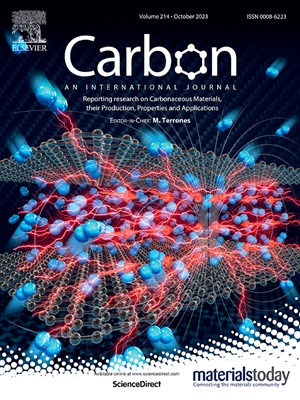石墨烯纳米板、碳纳米管和 C60 富勒烯在剪切应力作用下的无序化
IF 10.5
2区 材料科学
Q1 CHEMISTRY, PHYSICAL
引用次数: 0
摘要
本文章由计算机程序翻译,如有差异,请以英文原文为准。
Disordering of graphene nanoplatelet, carbon nanotube and C60 fullerene under shear stress
Carbon nanomaterials typically possess excellent mechanical properties, enabling them to withstand extreme physical environments. However, the response of different nanostructures under shear stress has not yet been experimentally investigated. In this study, we employ the rotational diamond anvil cell to apply pressure and shear to three carbon nanomaterials–graphene nanoplatelet, multi-wall carbon nanotube and C60 fullerene–and investigate their structure evolution using Raman spectroscopy and electron microscopy. Detailed analysis revealed that the materials exhibit distinct changes in their intrinsic structure. Specifically, defects and lattice distortion were introduced into graphene nanoplatelet, carbon nanotube broke down into curly graphene fragments, and C60 completely transformed into amorphous carbon. The most compelling discovery is the remarkably high degree of amorphization process in C60 at room temperature, accompanied by an sp3 hybridization fraction reaching 20.84 %. Our results underscore the profound impact of shear stress on the stability of carbon-based nanomaterials, provide new insights into their mechanical behavior and potential limitation in practical application, and offer a strategy for regulating these materials which have the strongest covalent bonds.
求助全文
通过发布文献求助,成功后即可免费获取论文全文。
去求助
来源期刊

Carbon
工程技术-材料科学:综合
CiteScore
20.80
自引率
7.30%
发文量
0
审稿时长
23 days
期刊介绍:
The journal Carbon is an international multidisciplinary forum for communicating scientific advances in the field of carbon materials. It reports new findings related to the formation, structure, properties, behaviors, and technological applications of carbons. Carbons are a broad class of ordered or disordered solid phases composed primarily of elemental carbon, including but not limited to carbon black, carbon fibers and filaments, carbon nanotubes, diamond and diamond-like carbon, fullerenes, glassy carbon, graphite, graphene, graphene-oxide, porous carbons, pyrolytic carbon, and other sp2 and non-sp2 hybridized carbon systems. Carbon is the companion title to the open access journal Carbon Trends. Relevant application areas for carbon materials include biology and medicine, catalysis, electronic, optoelectronic, spintronic, high-frequency, and photonic devices, energy storage and conversion systems, environmental applications and water treatment, smart materials and systems, and structural and thermal applications.
 求助内容:
求助内容: 应助结果提醒方式:
应助结果提醒方式:


